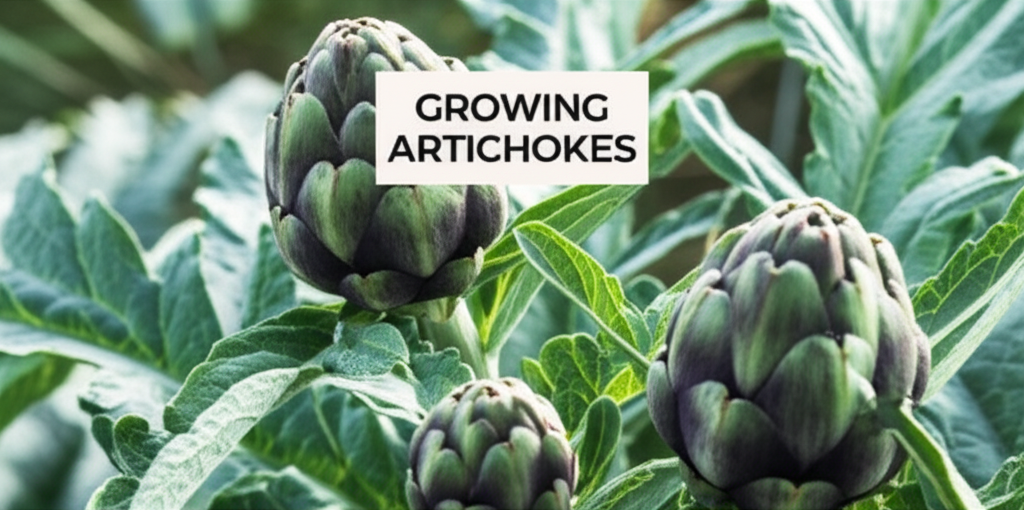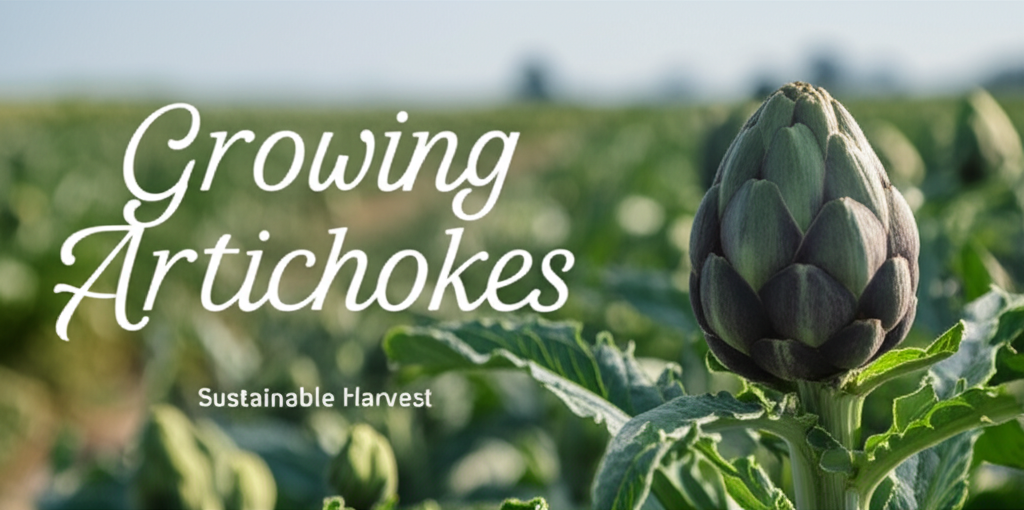The Enduring Appeal of Globe Artichokes in Sustainable Farming
Globe artichokes, scientifically known as Cynara cardunculus var. scolymus, are more than just a culinary delicacy; they represent a significant and often overlooked component of sustainable agriculture. Their unique growth habit, perennial nature, and resilience make them an ideal crop for farmers seeking to enhance biodiversity, improve soil health, and diversify their income streams. This article delves into the multifaceted benefits and practical considerations of integrating globe artichokes into a sustainable farming system, exploring their ecological advantages, economic viability, and the best practices for their cultivation.
Understanding the Globe Artichoke: A Perennial Powerhouse
Unlike many annual vegetable crops, globe artichokes are robust perennials. Once established, they can produce a harvest for several years, typically 5-10 or even longer with proper care. This longevity significantly reduces the need for annual land preparation and replanting, a key tenet of sustainable practices that minimizes soil disturbance and associated erosion.
The plant itself is striking, with large, silvery-green, deeply lobed leaves forming a substantial clump. From this base, edible flower buds develop, protected by layers of fleshy bracts. The edible portion is the fleshy base of these bracts and the heart, or receptacle, at the bottom of the bud.
Ecological Advantages of Artichoke Cultivation
Integrating globe artichokes into a farm ecosystem offers a cascade of ecological benefits that align perfectly with the principles of sustainable agriculture.
- Soil Health Improvement: The extensive root system of globe artichokes helps to break up compacted soil, improving aeration and drainage. Their perennial nature means that the soil structure is continuously supported, reducing the risk of erosion. The large leafy biomass also contributes organic matter to the soil when the plants are pruned back annually.
- Biodiversity Enhancement: Globe artichokes provide valuable habitat and food sources for a range of beneficial insects, including pollinators and predatory insects that help control pest populations. Their large, showy flowers, even if harvested before fully opening, attract bees, butterflies, and other pollinators crucial for the broader agricultural landscape.
- Reduced Input Requirements: Once established, artichokes are relatively drought-tolerant and less susceptible to many common pests and diseases compared to annual crops. This translates to reduced needs for irrigation, pesticides, and herbicides, further contributing to a more environmentally friendly farming system.
- Carbon Sequestration: As a perennial plant with significant biomass, globe artichokes contribute to carbon sequestration in the soil. Their root systems and decaying plant matter store carbon, helping to mitigate climate change.
- Nutrient Cycling: Their deep roots can access nutrients from lower soil profiles, bringing them to the surface in their plant tissues, which then become available to other plants or decompose to enrich the topsoil.
Economic Viability in a Diversified Farm
While the ecological benefits are substantial, the economic case for growing globe artichokes in a sustainable agricultural setting is equally compelling. Diversifying a farm’s crop portfolio with specialty crops like artichokes can provide additional income streams and buffer against market volatility.
- Premium Market Value: Globe artichokes are often considered a specialty or gourmet vegetable, commanding higher prices than many staple crops, especially in local and farmers’ market settings.
- Extended Harvest Period: With proper management and selection of varieties, the harvest period for globe artichokes can be extended, providing a more consistent income flow throughout the growing season.
- Multiple Harvests from One Planting: As perennials, artichoke plants yield multiple harvests each year for several years, amortizing the initial establishment costs over a longer period.
- Reduced Labor Costs Over Time: While initial planting and setup require labor, the perennial nature means significantly less annual labor compared to constantly replanting annual crops.
- Potential for Value-Added Products: Beyond fresh market sales, artichokes can be processed into pickled artichoke hearts, marinated artichoke products, or even used in artisanal food preparations, opening up additional revenue opportunities.
Key Facts and Comparison: Globe Artichoke vs. Common Annual Vegetables
To better illustrate the advantages of globe artichokes in a sustainable context, let’s compare them to some common annual vegetables in terms of key agricultural characteristics.
| Feature | Globe Artichoke | Tomatoes | Lettuce | Corn |
|---|---|---|---|---|
| Plant Type | Perennial | Annual (often grown as annual) | Annual | Annual |
| Establishment Effort | Higher initial (planting crowns or young plants) | Moderate (seedlings) | Low (seeds or seedlings) | Moderate (seeds) |
| Lifespan | 5-10+ years | 1 season | 1 season | 1 season |
| Soil Disturbance (Annual) | Low (minimal tillage after establishment) | High (tillage, transplanting) | Moderate (tillage, sowing) | Moderate (tillage, sowing) |
| Pest/Disease Susceptibility | Moderate (can have specific issues like aphids, slugs) | High (blight, hornworms, etc.) | Moderate (aphids, slugs, mildew) | Moderate (corn borer, earworm) |
| Water Needs | Moderate (drought tolerant once established) | High | Moderate | Moderate to High |
| Fertilizer Needs | Moderate (benefits from compost/manure) | High | Moderate | Moderate to High |
| Market Value | Specialty/Premium | Commodity/Specialty | Commodity | Commodity |
Cultivation Best Practices for Sustainable Artichoke Farming

Successful globe artichoke cultivation requires careful planning and execution, focusing on practices that support their long-term health and environmental sustainability.
Site Selection and Preparation
Choosing the right location is paramount for artichoke success.
- Sunlight: Artichokes thrive in full sun, requiring at least 6-8 hours of direct sunlight per day.
- Soil Type: They prefer well-drained, fertile soil rich in organic matter. Sandy loam or loamy soils are ideal. Avoid heavy clay soils that can lead to root rot.
- Wind Protection: While not strictly essential, some protection from strong winds can prevent damage to the large leaves and flower stalks. Planting near hedgerows or other windbreaks can be beneficial.
- Soil Amendments: Incorporate generous amounts of compost or well-rotted manure into the soil before planting to boost fertility and improve soil structure.
Planting and Spacing
Globe artichokes are typically planted from crowns (pieces of the root system with visible buds) or from young plants started from seed.
- Planting Time: In most temperate climates, crowns are planted in early spring as soon as the ground can be worked.
- Spacing: Give artichokes ample space to grow, as they can form large clumps. Space plants 3-5 feet apart in rows that are 5-6 feet apart.
- Planting Depth: Plant crowns about 4-6 inches deep, ensuring the buds are pointing upwards and just below the soil surface.
Watering and Fertilizing
Consistent moisture and feeding are key to productive plants.
- Watering: Water deeply and consistently, especially during dry periods and when buds are forming. Drip irrigation is an excellent sustainable method, delivering water directly to the root zone and minimizing water loss through evaporation.
- Fertilizing: Artichokes are heavy feeders. Apply a balanced organic fertilizer or top-dress with compost and aged manure in early spring when new growth appears and again after the main harvest.
Pest and Disease Management (Sustainable Approaches)
While relatively hardy, artichokes can be susceptible to certain pests and diseases. Sustainable management focuses on prevention and natural controls.
- Common Pests: Aphids, slugs, snails, and artichoke plume moths can be problematic.
- Disease Prevention: Ensure good air circulation by proper spacing. Avoid overhead watering, which can promote fungal diseases.
- Organic Control Methods:
- Beneficial Insects: Encourage natural predators like ladybugs and lacewings by planting companion plants such as dill, fennel, and yarrow.
- Handpicking: Remove larger pests like slugs and snails by hand, especially in the early morning or evening.
- Insecticidal Soap/Neem Oil: For aphid infestations, a targeted application of insecticidal soap or neem oil can be effective.
- Row Covers: Lightweight row covers can protect young plants from early pest attacks.
Harvesting and Pruning
Proper harvesting and maintenance are crucial for continued production.
- Harvesting: Harvest buds when they are firm and the bracts are still tightly closed, usually about 1-3 inches in diameter. Cut the stalk about 1-2 inches below the bud.
- Encouraging Side Shoots: After the main terminal bud is harvested, the plant will often produce smaller side shoots, extending the harvest.
- Winter Protection: In colder climates, it’s essential to protect the crowns over winter. After the first hard frost, cut the stalks back to about 6 inches. Then, cover the plants with a thick layer of mulch (straw, shredded leaves, or compost) to insulate the roots.
- Renewal Pruning: Every few years, the plant can become less productive. You can rejuvenate older plants by cutting them back severely in late winter or early spring, encouraging new, vigorous growth. Alternatively, divide the root crowns to create new plants.
Steps to Establishing a Sustainable Artichoke Patch
Here’s a simplified breakdown of the process for integrating artichokes into your sustainable farm.
| Step | Description | Sustainable Considerations |
|---|---|---|
| 1. Site Selection | Choose a sunny, well-drained location with fertile soil. | Minimize soil disturbance, consider proximity to water sources for efficient irrigation. |
| 2. Soil Preparation | Amend soil with compost or aged manure. Test soil pH and adjust if necessary. | Build soil organic matter, use locally sourced amendments. |
| 3. Planting | Plant crowns or young plants in early spring, spaced 3-5 feet apart. | Use certified disease-free plant material. |
| 4. Watering | Provide consistent, deep watering, especially during dry spells. | Utilize drip irrigation or ollas to conserve water. |
| 5. Fertilizing | Apply organic fertilizer or compost in spring and after harvest. | Use slow-release organic fertilizers; avoid synthetic inputs. |
| 6. Pest/Disease Monitoring | Regularly inspect plants for pests and signs of disease. | Prioritize integrated pest management (IPM) strategies. |
| 7. Harvesting | Harvest buds when firm and tightly closed. | Harvest at peak maturity for best quality. |
| 8. Winter Protection (if applicable) | Cut back plants and mulch heavily in colder climates. | Use organic mulching materials. |
| 9. Ongoing Maintenance | Weed control, occasional pruning, and rejuvenation. | Mulch to suppress weeds and retain moisture; practice crop rotation for soil health. |
Challenges and Considerations
While the benefits are clear, farmers should be aware of potential challenges.
- Climate Limitations: Globe artichokes prefer Mediterranean climates with mild winters and cool, moist summers. They can struggle in areas with very hot summers or very cold winters without adequate protection.
- Pest Pressure: While generally robust, specific pests like artichoke plume moths can require diligent management.
- Initial Investment: The cost of purchasing crowns or young plants can be higher than for seeds of annual vegetables.
- Learning Curve: Understanding the specific needs of a perennial crop like artichokes, including winter protection and renewal pruning, requires a learning investment.
Conclusion: A Sustainable Choice for the Future of Farming
Globe artichokes offer a compelling pathway for farmers looking to build more resilient, biodiverse, and profitable agricultural systems. Their perennial nature, soil-enriching properties, and ability to support beneficial insects make them a cornerstone of sustainable practice. By embracing best practices in cultivation, pest management, and harvesting, farmers can unlock the full potential of this ancient and rewarding crop, contributing to a healthier planet and a more secure food future. Integrating globe artichokes is not just about growing a unique vegetable; it’s about cultivating a more sustainable and ecologically sound approach to agriculture.


